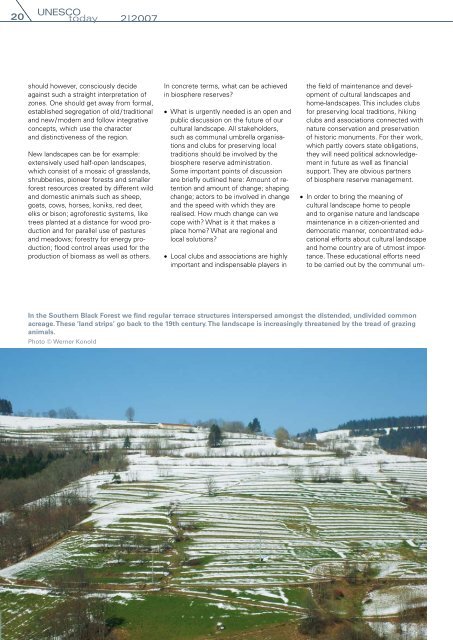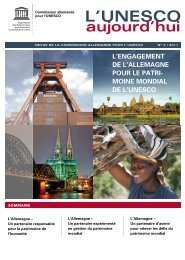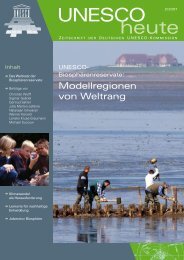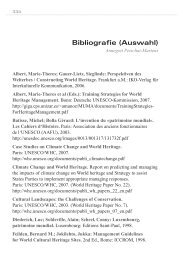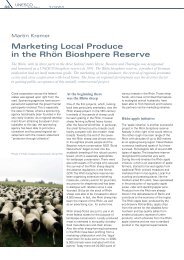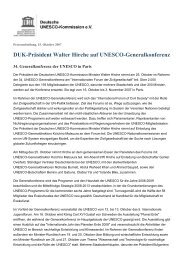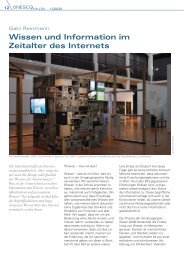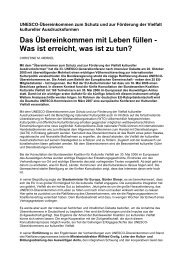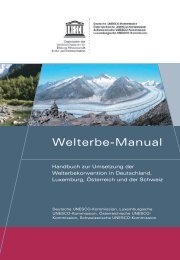Biosphere Reserves - UNESCO Deutschland
Biosphere Reserves - UNESCO Deutschland
Biosphere Reserves - UNESCO Deutschland
You also want an ePaper? Increase the reach of your titles
YUMPU automatically turns print PDFs into web optimized ePapers that Google loves.
0<br />
<strong>UNESCO</strong><br />
today 2|2007<br />
should however, consciously decide<br />
against such a straight interpretation of<br />
zones. One should get away from formal,<br />
established segregation of old / traditional<br />
and new / modern and follow integrative<br />
concepts, which use the character<br />
and distinctiveness of the region.<br />
New landscapes can be for example:<br />
extensively used half-open landscapes,<br />
which consist of a mosaic of grasslands,<br />
shrubberies, pioneer forests and smaller<br />
forest resources created by different wild<br />
and domestic animals such as sheep,<br />
goats, cows, horses, koniks, red deer,<br />
elks or bison; agroforestic systems, like<br />
trees planted at a distance for wood production<br />
and for parallel use of pastures<br />
and meadows; forestry for energy production;<br />
flood control areas used for the<br />
production of biomass as well as others.<br />
In concrete terms, what can be achieved<br />
in biosphere reserves?<br />
• What is urgently needed is an open and<br />
public discussion on the future of our<br />
cultural landscape. All stakeholders,<br />
such as communal umbrella organisations<br />
and clubs for preserving local<br />
traditions should be involved by the<br />
biosphere reserve administration.<br />
Some important points of discussion<br />
are briefly outlined here: Amount of retention<br />
and amount of change; shaping<br />
change; actors to be involved in change<br />
and the speed with which they are<br />
realised. How much change can we<br />
cope with? What is it that makes a<br />
place home? What are regional and<br />
local solutions?<br />
• Local clubs and associations are highly<br />
important and indispensable players in<br />
the field of maintenance and development<br />
of cultural landscapes and<br />
home-landscapes. This includes clubs<br />
for preserving local traditions, hiking<br />
clubs and associations connected with<br />
nature conservation and preservation<br />
of historic monuments. For their work,<br />
which partly covers state obligations,<br />
they will need political acknowledgement<br />
in future as well as financial<br />
support. They are obvious partners<br />
of biosphere reserve management.<br />
• In order to bring the meaning of<br />
cultural landscape home to people<br />
and to organise nature and landscape<br />
maintenance in a citizen-oriented and<br />
democratic manner, concentrated educational<br />
efforts about cultural landscape<br />
and home country are of utmost importance.<br />
These educational efforts need<br />
to be carried out by the communal um-<br />
In the Southern Black Forest we find regular terrace structures interspersed amongst the distended, undivided common<br />
acreage. These ‘land strips’ go back to the 19th century. The landscape is increasingly threatened by the tread of grazing<br />
animals.<br />
Photo © Werner Konold


